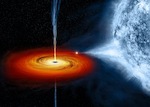Launch the probe

Your idea is to launch a probe to Cyg X-1, let it orbit for a little while, and then report back it's orbital speed in order to used Newton's law of universal gravitation to determine the mass of Cyg X-1. So, let's launch that probe!
First, you decide to take a step back. You know that you need the answer fairly quickly if you want to be the one to answer the challenge question first. Keeping this in mind, you do a quick calculation to see how long this would take.
You know from astronomy class that the speed of light is the absolute speed limit in nature. Your probe would actually travel much slower than that, but if you calculate how long it would take light to get to Cyg X-1 and back again, it will tell you the absolute fastest you could hope to get an answer.
It is an easy matter to calculate this minimum time, once you know the distance to Cyg X-1. The total distance traveled would be twice the distance to Cyg X-1.

A few helpful numbers:
- The distance to Cyg X-1 is 2.5 kiloparsecs
- A kiloparsec is a thousand parsecs
- A parsec is 3.0857 × 1016m.
- The speed of light in a vacuum is 3 × 108 m/sec


